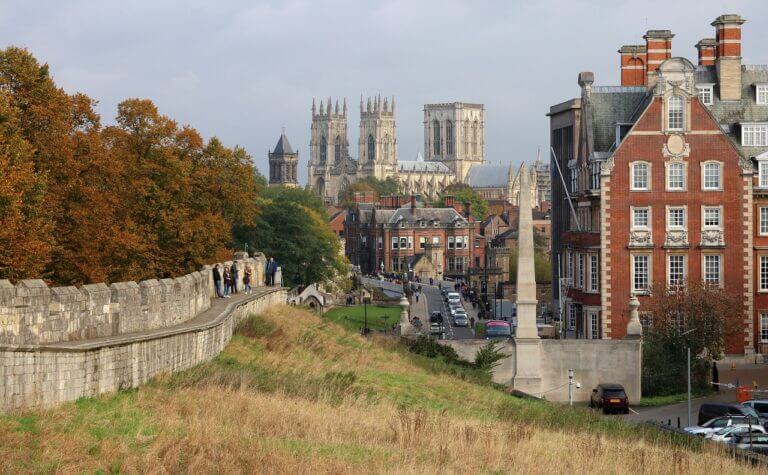Why is Thailand So Cheap? Cost of Travel to Thailand in 2024
Why is Thailand so cheap? This article will answer this question by looking at the economic reasons behind Thailand’s affordability. It will also cover the average costs of travelling in the Land of Smiles.
Thailand is one of the world’s most popular travel destination and with good reason. Whether it’s the glamorous skyscrapers of Bangkok, tranquil Buddhist shrines, stunning beaches, or exhilarating jungle adventures, Thailand offers a diverse array of attractions to suit all tastes and budgets.
For a typical tourist hailing from a developed country, Thailand is a highly affordable destination. Expenses such as accommodation, meals, transportation, and activities generally cost less compared to Western nations.
I have visited Thailand several times now and have experienced the country at different price points. Since I also have an interest in how economics work, I wanted to delve deeper into the reasons why Thailand is relatively cheap for tourism.
A word of warning, this article covers some complex economic concepts and terms, so if you are mainly interested in budgeting tips for your next Thailand trip, skip to the ‘Cost to Travel Thailand” section.
Without further ado, let’s delve into the details why Thailand remains such an affordable destination for travellers and the cost of travel there. The prices are going to be in US dollars as it is a global currency.
Disclosure: Some of the links below are affiliate links, which means that at no additional cost to you, I may earn a small commission if you click through and make a purchase. Please note, I only recommend products and services that I know and love. Read full Privacy Policy here.
Why is Thailand So Cheap? An Economic Overview
The primary factors contributing to many people’s views of Thailand as a cheap destination are its lower labour costs, a weaker currency relative to global powers, and the country’s economic dependence on sectors with lower productivity. These conditions are further amplified by government policy.
Moreover, the wealth of locally sourced produce and intense competition within the tourism industry also play pivotal roles in maintaining the country’s low costs of certain goods and services.
Lower Labour Costs
A significant factor contributing to Thailand’s affordability from a foreign tourist’s perspective lies in the country’s lower labour costs.
At the time of writing, the minimum wage in Thailand ranges between 328 baht (US$9.43) per day to 354 baht (US$10.18) per day (Source: ASEAN Briefing), depending on the region. This amounts to a monthly income of between 9,000 baht (US$260) and 10,000 baht (US$288).
Interestingly, this wage rate is higher than the minimum wage in several other countries in the region. This explains why Thailand has become a popular migration destination for individuals from less developed nations like Myanmar and Cambodia.
The average monthly wage in Thailand is 15,416 baht per month or just under US$450. In the capital city of Bangkok, the average monthly salary goes up to about $650 a month. This is substantially lower than what a Western tourist earns on average in their home country.
Economic Productivity
You might wonder why wages in Thailand are so low compared to those in developed countries. A key factor affecting wages is the country’s economic productivity.
What is productivity? It is defined as the efficiency of production and measures the output per a given set of inputs, such as labour, capital, and other resources.
This concept helps assess the efficiency of labour, companies, and even entire countries in producing goods and services. In simplified terms, the goal is to produce as much economic value as possible in the shortest amount of time.
Thailand’s economy significantly lags behind the productivity levels of developed countries. Does this mean that Thai workers are less hardworking or slower than those from developed nations?
Not at all. Productivity growth depends on investments in infrastructure, technology, research and skillsets. Unfortunately, the Thai government has historically focused on lower-productivity industries.
The main industries driving the Thai economy are tourism, agriculture, and low-tech to medium-tech manufacturing. These do not generate the same economic value as the sophisticated high-tech industries dominant in Western economies.
Additionally, these industries predominantly require low or unskilled labour, a workforce readily available due to the government’s historical limited investment in education. This surplus availability of workers also helps to suppress wage levels.
To summarise, due to the lack of investment in infrastructure and technology, there are fewer high-paying jobs in Thailand. Even if the government wanted to create these jobs, it would need to make a significant investment in education to ensure that workers are qualified to take them.
Lower Cost of Living
In general, countries with lower average wages have what appears to be a lower cost of living. This is because there is only so much the local population can pay for accommodation, transport, utilities and food.
However, it’s essential to note that “cheap” is a relative term. If you have already been to Thailand, you would know that $450 let alone $260 is not going to stretch far even in cheaper regions of the country.
Over 10% of Thailand’s population live in poverty, defined as those surviving on $5.50 a day or less. There is also a huge economic divide between the urban and rural population. Remember, the face of poverty in Thailand significantly differs from what is perceived as poverty in the Western world.
Nevertheless, if you are used to Western prices and are earning a Western wage, you will be pleased about how much your money can buy. Credit the lottery of birth and the concept of purchasing power parity for this.
Weaker Currency
Another reason why Thailand is considered a cheap destination for overseas tourists is its currency. Although it has proved resilient and relatively stable over the past few decades, the Thai Bhat is weaker than the likes of the US dollar, the Euro or the British Pound.
For example, as of January 2024, the current exchange rate is as follows:
- 1 USD = 35.66 baht
- 1 EUR = 38.82 bhat
- 1 GBP = 45.35 bhat
The strength of a currency is influenced by many factors, including trade balance, inflation, government intervention, and reserve currency status. Owning a stronger currency, like those of many Western nations, increases your purchasing power as it allows you to buy more of the weaker currency.
In the case of Thailand, visitors from countries with stronger currencies effectively experience a higher purchasing power due to the favourable exchange rates. This means your home currency will convert into a larger amount of Thai Baht, allowing you to buy more goods and services for the same amount of money you would spend back home.
Tips for Money Exchange in Thailand
Please note, exchange rates can change rapidly, so be sure to check them before your trip. Also, it’s worth noting that the rates above are from the central banks, and they might vary slightly ‘on the ground’.
In general, for the best rates, the recommendation is to exchange money in Thailand, rather than in your home country. Airports and hotel exchanges are notorious for offering less favourable rates. You will be better off finding a regular bank branch or an ATM in your destination.
I normally exchange a small amount of money into baht in the UK or at the airport when I arrive in the country. This ties me over until I get to a place with better exchange rates.
Government Policies, Taxes and Regulation
The current government policies often reinforce the high levels of inequality and ineffective institutions.
It’s important to acknowledge that Thailand did undergo a major transformation in the second half of the 20th century marked by robust economic growth and a significant decrease in poverty rates.
However, more recently these efforts seem to have stalled resulting in economic stagnation. The reasons for that are complex and their in-depth analysis is outside the scope of this article.
Ultimately, the government hasn’t invested enough in education, infrastructure and creation of more high-skilled industries and jobs. Past poverty reduction strategies have worked to a degree but didn’t create the systemic changes needed for a more equitable growth in the living standards.
Taxation also serves as a tool through which the government can influence the price of goods and services. For example, the Thai government imposes significant tariffs on certain imported products including cars, alcohol and some clothing, making these products more expensive for the consumer.
Abundance of Local Produce
As I’ve mentioned before, Thailand has a large agricultural sector that caters to both domestic consumption and international exports. As a result, the country enjoys a vast supply of locally sourced produce.
The common local food items include rice, noodle, tropical fruit, vegetables, fish, seafood, and meat. When these are paired with the lower labour costs, the final prices at the supermarket or local market end up being quite affordable, particularly from a Western perspective.
However, it’s important to note that imported foods, particularly those subjected to high tariffs, can carry a hefty price tag. Dining at Western-style restaurants can be significantly more expensive compared to consuming local street food, which typically relies solely on locally sourced ingredients.
If you venture into upscale Western restaurants, particularly those with Michelin stars in Bangkok, you’ll find that the prices are only marginally lower than what you might expect back home.
Competition in the Tourism Industry
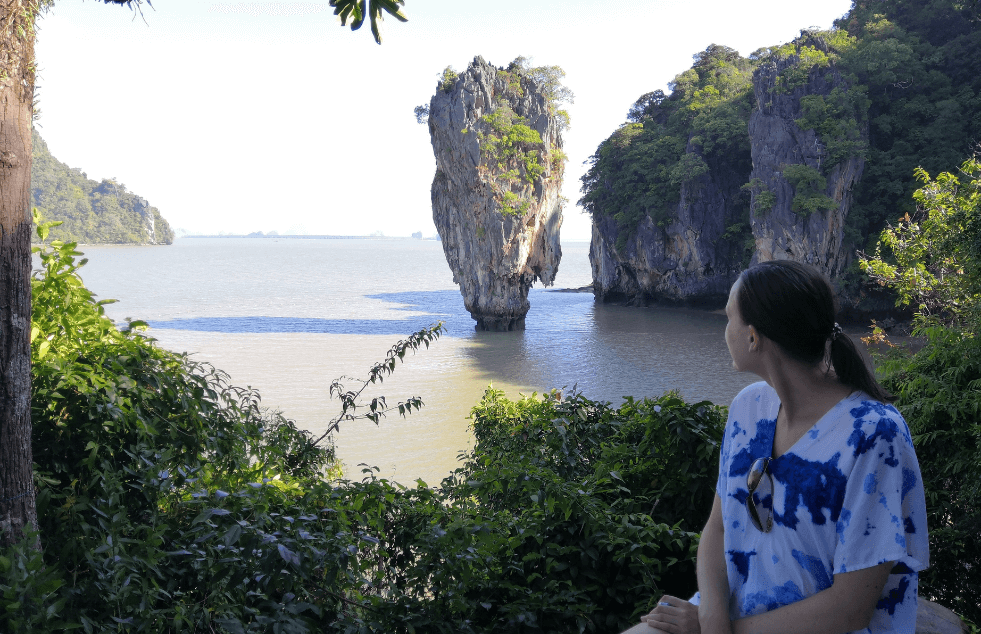
As tourism is a key economic driver and a significant subset of the population is involved in it, competition for tourist dollars is fierce.
Competition among accommodation providers, food outlets and tour companies helps to keep the cost of Thai holidays low. Some companies, especially those catering to Chinese tourists, offer extremely well-priced package tours. However, these have stirred controversy as the generated revenue does not always benefit the local community.
Regrettably, the affordability of Thailand’s tourism industry has a darker aspect. Workers face low wages, extremely long working hours, unstable employment, and sometimes even appalling living conditions.
Unfortunately, merely opting for upscale hotels does not ensure that the staff are treated ethically. Several luxury resorts and businesses tied to major international package tour providers have been implicated in worker exploitation.
Further in this article, I’ll discuss how tourists can use their money to benefit the individuals who create their unforgettable travel experiences receive better compensation for their efforts.
Cost to Travel Thailand
One reason why Thailand is such an appealing destination is that it offers amazing experiences for all kinds of budgets. The following section offers a breakdown of how much you need to budget based on your preferred travel style. It also provides detailed cost information on accommodation, transportation, food, and experiences.
How Much Money Do You Need Per Day in Thailand?
Budget: $30 to $70
This budget will cover a stay in a private room at a budget hotel or hostel, meals from street vendors, local bus travel, and low-cost tours. Opting to stay in a dorm can make your budget go even further.
It’s possible to spend even less than $30 a day if you’re particularly frugal. However, if you’re traveling halfway across the globe to experience Thailand, it’s worth considering if extreme frugality would genuinely allow you to experience the best that the country has to offer.
Mid-range: $80 to $180
With a mid-range budget, Thailand provides an impressive value-for-money experience, offering luxuries that typically cost more in developed countries.
This budget level broadens your options for accommodation, dining, and activities. You can afford to stay at hotels with better amenities, sample different dining options from street food to higher-end restaurants and spend more money on exciting tours and activities.
Luxury: $200+
If you are looking to splurge, Thailand has a wealth of incredible options from high end resorts and Michelin star dining to private tours and designer shopping. The sky’s the limit here.
Although Thai luxury experiences are generally less expensive than their Western equivalents, the costs will add up. Also, the more exclusive the experiences you are after, the more comparable the prices become with their international counterparts.
Cost of Accommodation in Thailand
Accommodation is likely to be your most significant cost after airfare during your stay in Thailand. Prices for accommodation can vary dramatically depending on both the location and season.
Popular destinations like Bangkok and Phuket usually command higher prices compared to lesser-visited spots such as Koh Chang or Chiang Rai. Nevertheless, good-value accommodation can still be found in the most popular locations too.
Hostel dorms are the most budget-friendly accommodation option in Thailand, where you can get a bed for as little as $5-$6 per night. If you prefer a private room with shared amenities, you can expect to pay between $12 and $18 per night.
For a private room with an en-suite bathroom at a budget hotel, expect to pay somewhere between $25 and $30 per night. However, this would still be a relatively basic accommodation option.
Mid-range accommodation, which include a variety of independent boutique hotels, self-catered options, and international chains, generally fall within the range of $40 to $100 per night.
As for high-end hotels, pricing starts around $100 per night. Naturally, the more luxurious and exclusive the hotel, the steeper the price. For instance, a night at the Mandarin Oriental Bangkok starts from $700, while the iconic Six Senses Yao Noi resort could cost you at least $1,000 per night.
As previously mentioned, when you’re prepared to splurge, Thailand offers a wealth of options.
If you feel overwhelmed by the wealth of accommodation options, here are a few of my favourites to help you plan your trip.
Bangkok: Anantara Riverside Bangkok Resort – from $140 per night
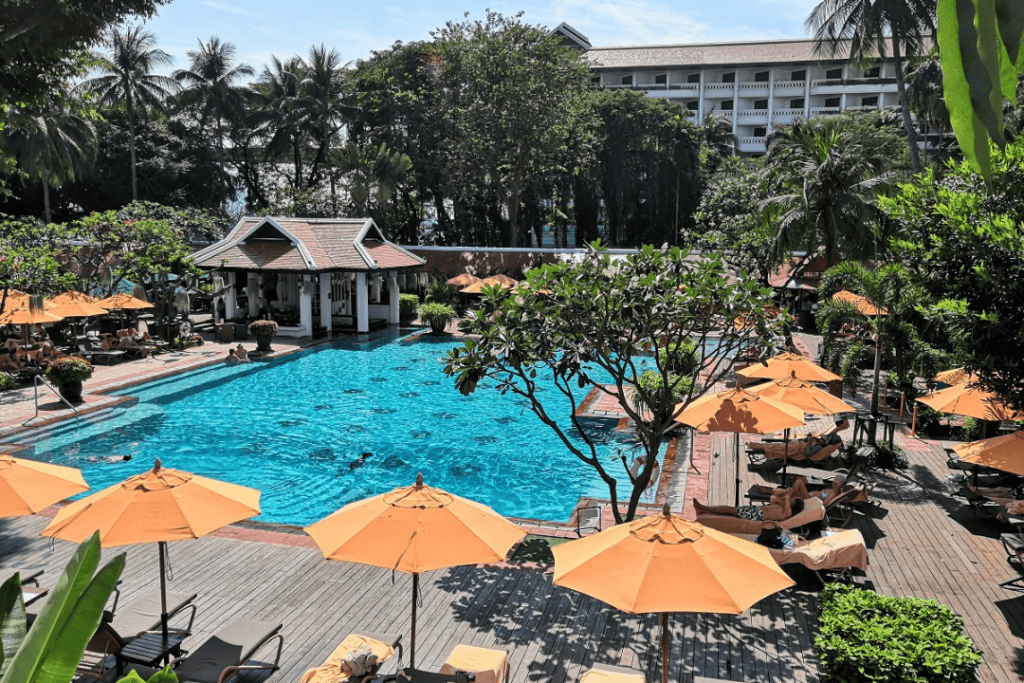
This beautiful resort, inspired by traditional Thai style, offers tranquillity in the heart of a bustling city. My husband and I stayed there during our Southeast Asia honeymoon and loved its resort feel. You can choose to spend your days exploring the city or relaxing by the generous pool. If you’d like to find out more, check out my review of this Anantara hotel.
Patong, Phuket: Phuket Marriott Resort & Spa, Merlin Beach – from $90 per night

We stayed there on our first trip to Phuket and loved its location by the scenic Merlin Beach, a 20-minute drive from Phuket’s main tourist town, Patong. It meant that we could enjoy the nightlife, dining, and other activities that Patong has to offer without having to stay in a busy area.
Cape Panwa, Phuket: Pullman Phuket Panwa Beach Resort – from $130 per night
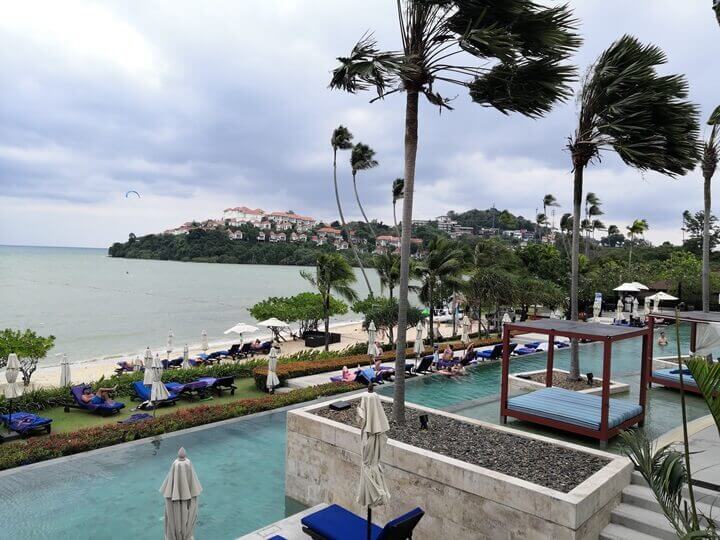
This was another honeymoon spot for us, which is why we opted for a private villa with our own pool. It was a fantastic choice, as the beach isn’t the best in Phuket. However, if you’re seeking pure relaxation in a tranquil spot, both Cape Panwa and the Pullman are excellent options.
Transport Costs
Thailand has a great selection of transport options making travel locally and around the country easy and straight forward. In general, transportation in Thailand is relatively cheap for foreign tourists. Let’s explore a few of the popular transport options.
Plane
Many Thai cities and popular tourist destinations such as Phuket and Koh Samui have airports. Air travel is the fastest way to travel in Thailand but is also the most expensive. For example, a one-way flight from Bangkok to Phuket or Krabi costs around $60 to $70 per person.
Train
Thailand has an extensive rail network that offers a great way to see the country. It’s also an affordable and a more environmentally friendly way to travel.
A third-class seat on a popular route, such as Bangkok to Chiang Mai, can be as inexpensive as $7-$8. For those seeking more comfort, potentially coupled with air conditioning, a second-class sleeper ticket will set you back approximately $20-$25 per person. A berth in the first-class sleeper compartment available on some modern trains will cost around $40 – $45 per person.
Just a note, Thai trains can be a little old and tired compared to the modern ones in the developed countries. They can also be a little slow and shaky.
Coach
Travelers in Thailand can access all major cities and towns via coach services. Although this mode of transport may not be the quickest, it offers an affordable travel option. There are two types of coaches to choose from.
First, there are regular long-haul coaches typically used by locals. These usually cost just a few dollars for a one-way ticket. However, they are far from luxurious.
Alternatively, there are more comfortable VIP and VIP24 coaches, operating out of Bangkok. These offer a much more comfortable experience, with tickets priced around $10 to $40 depending on the distance covered.
Ferry
If you are planning on island-hopping in Thailand, inter-island ferry trips will likely be part of your experience. These ferries provide not only an easy and comfortable way to travel, but also offer scenic views along the way. Generally, the cost of ferry tickets varies from about $12 to $17 per person.
BTS Skytrain & MRT (Bangkok only)
These transport networks are modern, comfortable and efficient and offer a great way to get around Bangkok. BTS Skytrain is an elevated train network that has a good coverage of Bangkok’s business districts. MRT is an underground train network that covers a large area of the city.
Depending on the length of your journey, one-way BTS fares range between $0.50 and $1.50. MRT fare. One day BTS travel pass costs around $4. MRT costs are similar.
Local Buses
Local buses are one of the cheapest ways to travel within cities and towns. If you are after a truly local transport experience, this is the go-to option.
Don’t expect too many comforts though. Many local buses lack air conditioning, can become crowded, and often do not provide signage in English.
The non-air-conditioned buses are typically the least expensive, with single tickets usually priced between $0.20 and $0.30. Meanwhile, air-conditioned bus fares generally range from $0.32 to $0.90.
Metered Taxis
Taxis are in abundance in Thailand and relatively cheap by Western standards. Nevertheless, fares can differ significantly based on location. In Bangkok, for example, the initial cost for the first kilometre is around 40 baht, which is slightly above $1.00. Subsequent kilometre charges start from 6.50 baht/km (roughly $0.20/km), and these rates incrementally increase with distance.
Please note, although taxis should have meters on, many drivers may try to offer you a flat rate. This is how they attempt to make more money. In theory, you should ask the taxi driver to put the meter on. However, in my experience it never happens. I have accepted flat rates in the past, but they were normally affordable for me anyway.
Also, be aware of potential taxi scams. If a taxi driver approaches you with suggestions to take you to some nice places, politely decline and find another taxi.
Ride-hailing apps such as Grab, Bolt and InDrive are providing an alternative to dealing with regular taxis. This guide gives the lowdown on ride-sharing options in Thailand.
Tuk-tuks
Taking a tuk-tuk ride in Thailand is almost a quintessential experience for any traveller. They are a relatively cheap way to get around and locals themselves often use them for short trips. There is no meter, so it’s best to agree a price before your trip.
While a local could probably get a short ride for 50 baht ($1.50), tuk-tuk drivers typically demand higher fares from foreigners. Be prepared for some haggling to get a better deal. While you will most likely end up paying more than a local would, an extra dollar is usually an insignificant amount for most tourists. This is not something I would lose my sleep over.
Cost of Food in Thailand
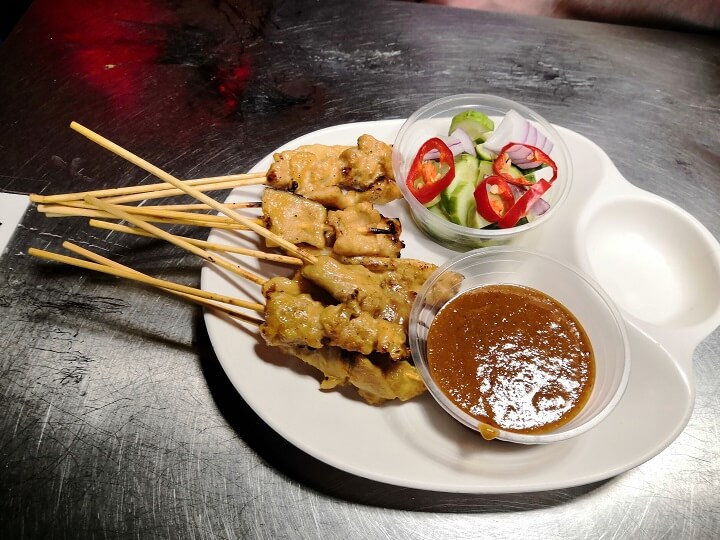
Thai food is considered one of the most delicious in the world because of its variety and exciting flavours. So, how much would a typical meal cost in Thailand? This of course will depend on the style of dining and the location.
Budget
Thailand is famous for its street food and to this day it is the most budget style of eating in the country. Diverse and packed full of flavour, it is an absolute must-try experience while visiting the country, whatever you budget.
A meal at a street food stall would normally cost between 30 and 100 baht ($1.00 – $3.00) per person. Prices may be a little higher in touristy areas, but for most overseas visitors will still find the food remarkably affordable.
Mid-range
A meal at a restaurant can cost anywhere between 300 baht ($9.00) and 1,800 baht ($50) for two, depending on how basic or up-scale the restaurant is and its location. Popular tourist areas are generally more expensive than the predominantly local areas.
Restaurants serving Western-style food are normally pricier than Thai and other Asian cuisines. As I’ve mentioned before, while locally produced food is cheap, imported ingredients are subject to tariffs resulting in higher costs for the consumer.
So, if you fancy some Australian lamp chops and a glass or two of Chilean wine to wash it down, prepare to pay a pretty penny for it.
High-end
If you are keen to try some of the most high-end restaurants, mainly located in Bangkok, expect to pay anything between $45 – $100 per person for a tasting menu. This is generally less expensive compared to comparable experiences in global cities like London or New York.
As a personal example, my husband and I went to the Blue Elephant restaurant in Phuket Old Town. Housed in a beautiful historic mansion, this restaurant serves a fine dining take on southern Thai cuisine.
We had the Peranakan tasting menu featuring 7 courses for 1,650 baht (£36.50 or US $46.50) per person. Comparable tasting sets in UK restaurants would easily be in the region of £60.00 – £70.00/US $76.00 – $89.00 per person).
Drink
Non-alcoholic drinks in Thailand, especially if you buy them from a regular shop like 7-Eleven, are quite affordable. For example, you can expect to pay between 15 – 20 baht (US $0.42 – $0.60) for a 1.5L bottle of water.
You can save even more by buying multipacks. Local brands are 100 – 140 baht (US $2.80 – $4.00) per crate of six 1.5L bottles, depending on the brand.
A 0.5L bottle of Coke or Pepsi also costs about 15 – 20 baht (US $0.42 – $0.60). Again, getting a multipack can cut the cost per bottle even further. The only challenge might be storage in your hotel room.
When it comes to alcohol, the price greatly depends on the origin of the drink. Thailand imposes high tariffs on imported alcohol, resulting in higher prices in shops and restaurants.
The cheapest alcoholic options are local beers, such as Chang and Singha. You can buy a bottle of either beer for 45-60 baht (US $1.70) at a supermarket. In bars and restaurants, the price of a beer ranges between 70 and 120 baht (US $2.00 – $3.40).
Imported wine and spirits are a bit more of a drain on your wallet. Wine prices vary immensely depending on many factors, including brand and vintage, so an average is hard to pinpoint.
The starting price for an adequate regular bottle of wine at a supermarket is 400-600 baht (US $11.30 – $17.00). For anything fancier, the sky is the limit. Expect to pay at least three times more for the same bottle at a restaurant.
A nice cocktail will set you back 350 – 450 baht (US $9.92 – $11.33). However, some high-end bars, like the famous Sky Bar at Lebua Hotel in Bangkok, can easily charge you three times more than that.
Tours and Activities
The many paying tours and activities geared towards tourists, although expensive for many locals, offer good value compared to many other international destinations. The cost also depends on what you’re doing.
Entrance fees are typically required for foreign visitors to museums and historical sites such as Wat Pho and the Grand Palace in Bangkok. Ticket prices vary between 200 baht ($5.50) and 500 baht ($14.50) per person. Thai citizens receive discounts and free entry.
Popular day activities like a trip to the floating markets near Bangkok, a cooking class or a basic island-hopping trip will range between $20 and $60 per person. Tours that cover more distance and involve more activities can cost up to about $150 per person.
If you prefer a private tour, expect to pay between $50 – $150 per person depending on where you’re going and the size of your group. Chartering a yacht for a private island-hopping experience can cost anywhere from $700 to $2,500 per group.
Thankfully, Thailand also offers many free activities. You can enjoy its beautiful beaches, stunning landscapes, hiking trails and some cultural sites at no cost.
Here is a selection of some of my favourite tours in Thailand:
- Phang Nga Bay: Early Bird James Bond & Beyond Tour – US $110.00 per person. My husband and I did this one when we were staying in Phuket. The early start is absolutely worth it.
- Phi Phi & Bamboo Islands: Premium Day Trip – US $105.00 per person.
- Bangkok: Damnoen Saduak Market and Maeklong Railway Market – US $66.00 per person.
- Bangkok: Midnight Food Tour by Tuk-Tuk – from US $66.00 per person. A trip to Bangkok will not be complete without trying all the amazing food there!
Is Thailand Cheap for Shopping?
The cost of shopping in Thailand will depend on where you shop and what type of products you buy.
The many local markets are a great place to shop on a limited budget. Although they are often packed with fakes and low-quality items, you can still find some interesting things to buy. If you are good at haggling, you are likely to get a bargain.
Shopping malls are an important part of Thai life, and you can find them in many cities across the country. Familiar international brands like H&M and Zara often dominate these. However, some malls like Siam Discovery in Bangkok also offer items created by local designers and makers.
In terms of the cost of shopping there, the costs are generally on par with those in developed nations. You may even find certain items to be pricier than what you’re used to back home. This is due to high tariffs on certain imported products.
Furthermore, Bangkok boasts a selection of luxury malls brimming with international designer brands like Louis Vuitton, Gucci, and Cartier. However, due to import duties and taxes, these high-end products are typically not cheaper than in other global locations.
Is Thailand Actually Cheap? The Truth About Cheap Thailand Travel
The truth is your views of whether Thailand is cheap or not will depend on your personal circumstances and this is something I think travellers should be mindful of.
If you are a tourist from a developed country, you are likely to be making significantly more money than an average Thai person. You will also be buying baht with a stronger currency giving you more purchasing power.
Under these circumstances, Thailand will be a relatively cheap destination for you. You will be able to experience a more luxurious and/or extended holiday than you would back home.
I would also add that countries like Cambodia, Vietnam and Laos are often cheaper than Thailand nowadays. However, Thailand offers more choice and is more developed than many of its less expensive neighbours.
Nevertheless, it’s worth remembering that while you might be having the time of your life in Thailand without draining your wallet, many locals do not perceive their country as cheap.
The Thai society is highly unequal and there is a huge economic gap between the rich and the poor, especially in the rural area. No matter which part of Thailand you live in, the $260-$280 minimum wage and even the average salary are not going to stretch far.
As tourists, our influence on the countries we visit can be both positive and negative. In the next section, I will provide suggestions on how the money we spend can make a positive impact on the communities we visit.
Ethical Travel in Thailand: Use Your Purchasing Power for Good
Here are some small steps that we can take to become better tourists and have a more positive economic impact. There are, of course, many other things we can do to make travel to Thailand more ethical and sustainable.
However, since this article focuses on the financial side of things, the following tips focus on what to do with your money.
Don’t Be a Cheapo
Certain travellers take pride in discussing how they’ve managed to get by in Thailand on $5, $10 or some other minimal daily budget. They treat it as an accomplishment. However, I don’t think this is a good mindset to have as it feels quite exploitative.
It also highlights the unfairness of the global economic situation. For instance, I’ve met young Westerners who saved enough money from basic hospitality work to travel around Thailand for weeks, if not months. In contrast, equivalent Thai hospitality workers might never be able to afford a plane ticket. The only real difference between the two is simply greater luck in the lottery of birth.
Ultimately, if you have enough money to travel halfway across the globe for a holiday, whether you are a backpacker or luxury traveller, you are wealthier than a significant portion of the world’s population.
Avoid nitpicking over every $0.50 and bear in mind that what may seem like a trivial sum to you can make a substantial difference to those contributing to your travel experience.
Tipping
One simple way to directly boost people’s income is through tipping. When planning your travel budget, set aside a small sum for the people that you are likely to be interacting with such chambermaids, restaurant staff, tour guides, hotel porters, and drivers.
Feel free to show extra generosity if someone goes above and beyond to deliver a remarkable experience for you. The level of service in Thailand is generally excellent, but you’ll encounter individuals who raise the bar even higher.
Eat Local
Whatever part of Thailand you visit, make an effort to try different locally run places to eat and drink outside your hotel. By doing so, you not only distribute the economic advantages of your visit to a broader range of local businesses, helping them flourish, but also indulge in a more genuine Thai foodie experience.
Visit Less Visited Destinations
As I’ve mentioned previously, Thailand suffers from significant regional inequalities. One way travellers can help is by spreading their hard-earned money far and wide, visiting destinations that are slightly off the beaten track.
Doing so will support locals in running successful businesses and provide local employment opportunities. Plus, you’ll get to experience more of what Thailand has to offer.
For example, if you are planning to spend some time enjoying the beaches of Phuket, why not also visit the nearby islands of Ko Yao Noi and Koh Yao Yai? Although only a short boat ride away, they offer a completely different experience from the bustling Phuket.
Purchase Artisan Souvenirs
If you would like to bring home a truly unique souvenir from Thailand, consider exploring the many local markets, artisan shops and artist studios. Thailand is rich in artisan traditions, encompassing craftwork such as carving, silverware, silk-making, and ceramics.
You’ll discover that many of these traditional handicrafts are often created by artisans from remote rural communities, for whom their craft is a vital source of livelihood.
By purchasing locally made artisan goods, you directly support these craftsmen and preserve traditional arts. Moreover, you get to take home a meaningful keepsake that’s crafted in Thailand, rather than mass-produced in a distant factory.
Final Thoughts
We’ve reached the end of this article. You should now have a basic understanding of the potential costs of travelling in Thailand to help you plan your own unforgettable trip there.
We’ve looked at the reasons why Thailand is perceived as a cheap tourist destination. Nonetheless, remember that context is essential when considering travel and living expenses in Thailand.
While overseas visitors may discover great value there, many locals do not consider Thailand cheap. The great thing is that as travellers we can make a positive impact on the communities we visit by spending our holiday money with local businesses.
Still wondering if Thailand is worth visiting? Check out this guide to the reasons why the Land of Smiles should be on your bucket list.
For further Thailand travel planning, check out these guides to the best things to do in Bangkok and Phuket, as well as a comparison between these destinations. These one-day and two-day itineraries will help you maximise your time in the Thai capital.
Phuket especially is a fantastic destination for a romantic winter sun holiday that won’t drain the wallet. Here is the round-up of the best places to stay in Phuket for couples for those looking for a dreamy getaway.
FAQs: Why Is Thailand So Cheap?
Thailand is a popular destination not only thanks to its relative affordability compared to other global hotspots, but also for the diverse range of experiences it offers. Its breathtaking beaches, rich culture, delectable cuisine, stunning natural landscapes, and bustling cities make it a diverse holiday destination. Regardless of what your dream holiday looks like, Thailand has the potential to fulfil it.
Your daily budget will depend on your style of travel. Budget travellers can expect to spend between $30 and $70 a day. A mid-range budget is normally between $80 and $180 a day. Seekers of luxury can expect to spend $200+ a day.
Some things such as locally produced food, public transport and accommodation is cheaper in Thailand than in many developed countries. However, certain items, especially if they are imported, such as alcohol, luxury goods and cars might even be more expensive than what you are used to back home.
Thailand is considered an affordable travel destination but it’s definitely not the cheapest. You will find that the nearby Southeast Asian countries like Cambodia and Vietnam are even easier on the wallet.
While Thailand is generally safe for tourists, it’s important to stay vigilant as minor crimes do sometimes occur. Ensure the safety of your possessions by always keeping them within sight to prevent theft, and exercise caution when interacting with strangers.
If someone’s intentions seem dubious, it’s best to politely decline further interaction.
Take note that road safety is a concern in Thailand, which has one of the highest per capita rates of road fatalities globally. Pedestrian crossings and traffic lights may not always be respected, so be cautious when crossing the street. Unless you’re an experienced rider, it’s recommended to avoid renting a scooter.
For ultimate peace of mind, secure comprehensive travel insurance prior to your trip.
Enjoyed this article on the costs of travel to Thailand? Bookmark or pin it for later.
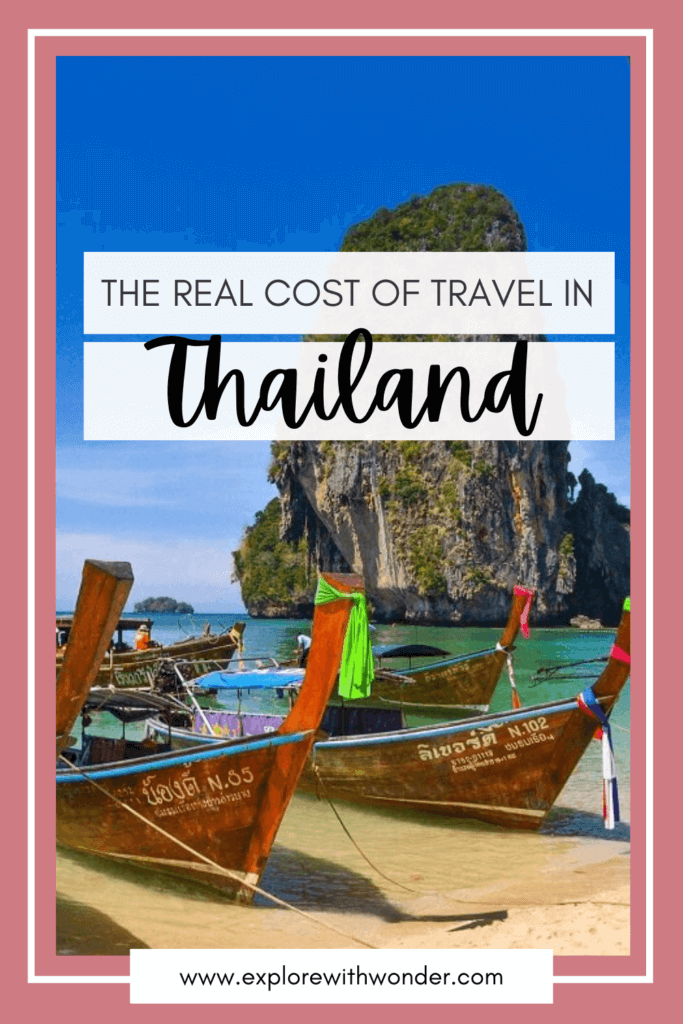
Related Reads: Thailand
- Is Thailand Worth Visiting in 2024? 17 Best Reasons to Visit Thailand
- What is Thailand Famous for? 23 Things You Need to Know
- Phuket or Bangkok: Which Should You Visit?
- Is Bangkok Worth Visiting in 2024? 17 Best Reasons to Visit Bangkok
- Best Areas to Stay in Bangkok in 2024
- Anantara Riverside Bangkok Resort Review
- Is Phuket Worth Visiting? 10 Reasons to Visit Phuket
- 24 Hours in Bangkok: The Ultimate Itinerary
- 2 Days in Bangkok, Thailand: The Definitive Travel Itinerary
- Where to Stay in Phuket for Couples: The Best Areas and Hotels
- Is There Uber in Thailand in 2024? Everything You Need to Know
- Does It Snow in Thailand? Everything You Need to Know
- Phuket in December: Everything You Need to Know in 2024




